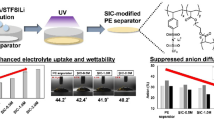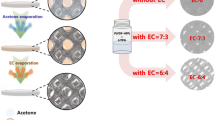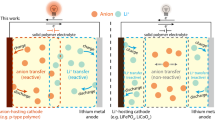Abstract
Anion receptor-coated separators were prepared by coating poly(ethylene glycol) borate ester (PEGB) as an anion receptor and poly(vinyl acetate) (PVAc) as a good adhesive material towards electrodes onto microporous polyethylene (PE) separators. Gel polymer electrolytes were fabricated by soaking them in an liquid electrolyte, 1 M LiPF6 in EC/DEC/PC (30/65/5, wt.%). As the weight ratio of PEGB to PVAc in a coating layer increased, gel polymer electrolytes showed higher cationic conductivity and electrochemical stability. The cationic conductivity and electrochemical stability of the gel polymer electrolyte based on coated separator with PVAc/PEGB (2/5, weight ratio) could reach 2.8 × 10–4 S cm–1 and 4.8 V, respectively. Lithium-ion polymer cells (LiCoO2/graphite) based on gel polymer electrolytes with and without PEGB were assembled, and their electrochemical performances were evaluated.
Similar content being viewed by others
Explore related subjects
Discover the latest articles, news and stories from top researchers in related subjects.Avoid common mistakes on your manuscript.
Introduction
Anion receptors have recently been considered as a good component in the electrolytes for lithium secondary batteries, since they can form stable complexes with anions, and thereby enhance electrochemical and thermal stability of anions by suppressing the decomposition reaction of anions [1, 2]. They can also contribute to the increase of lithium ion transference number and dissociation fraction of lithium salt [3, 4]. These anion receptors have been used as an additive for liquid electrolytes [1–4] or a plasticizer or polymer matrix for polymer electrolytes [5–7]. In the former case, only small amounts of anion receptors with low molecular weight could be used in order not to increase the viscosity of liquid electrolytes. On the other hand, oligomers such as poly(ethylene glycol)-borate esters (PEGB) with various chain length could be introduced to polymer electrolytes because the viscosity of polymer electrolytes was not as important as that of liquid electrolytes. However, polymer electrolytes containing anion receptors as plasticizer or polymer matrix have not been commercialized due to their poor mechanical strength.
In order to give polymer electrolytes mechanical strength, separator-supported polymer electrolytes were manufactured by coating polymer electrolytes upon a microporous separator, and thereby could be commercialized as lithium-ion polymer batteries [8–10]. In this work, with this concept, new gel polymer electrolytes based on anion receptor-coated separator were prepared, and the influence of anion receptor on the transference number and electrochemical stability was investigated. In addition, the electrochemical performances of lithium-ion polymer cells composed of LiCoO2/graphite were evaluated.
Experimental
Synthesis of PEGB
PEGB was synthesized by the dehydrocoupling reaction of poly(ethylene glycol) methyl ether (Mn = 2,000, n = 45, Aldrich) and BH3/tetrahydrofuran (THF) complex solution (1 M, Aldrich) as described in Fig. 1 [11]. The produced PEGB was dried in a vacuum oven at 100°C for 24 h to remove residual THF and kept in a glove box. 1H-NMR and Fourier transform infrared spectroscopy (FT-IR) were used to characterize the structure of PEGB.
Preparation and characterization of anion receptor-coated separators
Coating solutions were prepared by dissolving an appropriate amount of PEGB and poly(vinyl acetate) (PVAc, Mw = 500,000, Aldrich) with different weight ratios (7/0, 5/2, 4/3, 3/4, 2/5) in methanol. A microporous PE separator (Asahi-Kasei, thickness 20 μm) was immersed in each coating solution, and then taken out and left to evaporate the solvent at room temperature. After evaporation of the solvent, the coated separator was dried under vacuum for 24 h to remove the residual solvent and water trace. The thickness of coating layer was found to be about 5 μm. The surface morphology of separators was investigated by scanning electron microscopy (SEM) using the Philips SEM 535 M.
Preparation of lithium-ion polymer cells with gel polymer electrolytes based on coated separators
The gel polymer electrolytes were prepared by soaking the coated separators in a liquid electrolyte (1 M LiPF6 in EC/DEC/PC 30/65/5 wt.%, Cheil Industries), and then sandwiched between LiCoO2 cathode and graphite anode for lithium-ion polymer cells. Both electrodes were also soaked in the same liquid electrolyte before cell assembly in order to fill the pores in the electrodes. The cells were finally packaged in an aluminized polyethylene bag and vacuum sealed in a glove box filled with argon.
The electrodes used in this work were fabricated as follows. The anode was prepared by coating a slurry containing 95 wt.% natural graphite and 5 wt.% poly(vinylidene fluoride) (PVdF, Elf Atochem) binder in N-methyl-2-pyrrolidone (NMP, Aldrich) on a copper foil. The cathode slurry consisting of 88 wt.% LiCoO2, 6.8 wt.% Super-P (MMM carbon), and 5.2 wt.% PVdF binder in NMP was cast on aluminum foil. The dried electrodes were roll pressed to enhance both particle contact and adhesion to the current collector foils. The loading amount of cathode active material corresponded to a capacity of 2.4 mAh cm−2.
Electrical measurements
The gel polymer electrolytes based on anion receptor-coated separators were sandwiched between the two stainless steel electrodes to measure ion conductivities. The ionic conductivities were obtained from bulk resistance measured by a.c. complex impedance analysis using a Solartron 1255 frequency response analyzer in combination with a Solartron 1287 electrochemical interface over frequency range of 100 Hz~1 MHz under amplitude of 10 mV. The transference number of lithium cation (t Li) was investigated by means of the potentiostatic polarization measurement [12]. A constant polarization of 10 mV was applied to Li/Li symmetric cells. The transference number was calculated by the relation (\( {t_{\rm{Li}}} = {I_{\rm{s}}}/{I_0} \)). The electrochemical stability of gel polymer electrolytes was determined by linear sweep voltammetry experiment performed on a stainless steel (SS304) electrode as a working electrode with lithium as a reference electrode at a scanning rate of 2 mV s−1.
The lithium-ion polymer cells (cell size: 2 × 2 cm2) were cycled between 3.0 and 4.2 V at a constant current density(0.2C, 0.48 mA cm−2) at room temperature using a TOSCAT-3000U instrument (Toyo System Co. Ltd). The charge process was cut-off at 20% of the initial constant current.
Results and discussion
Among various anion receptors, PEGB was taken as a coating material for a PE separator because its chain length could be easily controlled by that of reactant, poly(ethylene glycol) methyl ether, as shown in Fig. 1. The chain length of PEGB must exceed the chain entanglement level for dimensional stability of coating layer even in case of being immersed in liquid electrolytes. For higher boron content in gel polymer electrolyte, on the contrary, it is desired that the chain length of PEGB must be as short as possible. With these reasons, PEGB with number average molecular weight (Mn) about 6,000 was synthesized and used in this work. PVAc was selected as a reference coating material due to its good affinity with liquid electrolytes and adhesive property towards electrodes [13]. The compatibility between PEGB and PVAc was confirmed by the existence of one glass transition temperature of PEGB/PVAc blend in DSC thermogram.
The ion conductivities of gel polymer electrolytes prepared by soaking the coated separators in a liquid electrolyte (1 M LiPF6 in EC/DEC/PC 30/65/5 wt.%) are listed in Table 1. It is found that the ion conductivities of gel polymer electrolytes are higher than that of bare separator, which is closely related to the uptake amount of liquid electrolyte into separators. In case of coated separators, as the content of PEGB in the coating layer increases, the ion conductivities of gel polymer electrolytes gradually decrease due to the decrease of uptake amount and the suppression of anion migration. It may be originated from less dense structure of coating layer as shown in Fig. 2 and increase of anion receptor content, respectively. However, the transference numbers of gel polymer electrolytes increase with increase of PEGB content in coating layer. It is because PEGB in the coating layer may function properly as an anion receptor to suppress the migration of anions by forming the stable complexes with anions. As a result, even though gel polymer electrolytes with higher PEGB content showed lower ion conductivities, their cationic conductivities increased with increase of PEGB content due to much enhanced transference number. For the highest cationic conductivity, coated separator based on 71 wt.% PEGB was taken for further electrochemical experiments.
The surface morphology of the bare and coated separators is shown in Fig. 2. It is found that the microporous surface structure of bare separator is completely covered with coating materials in both coated separators. However, the morphology of coating layer in the coated separator with 71 wt.% PEGB became coarse and porous. It may be originated from lower molecular weight of PEGB than those of general polymers and the insufficient solubility of PEGB in methanol. It is well-known that the phase separation between polymer and solvent is accelerated when the solubility of polymer in a solvent is poor and the evaporation rate of solvent is fast [14]. Large solvent-rich regions caused by phase separation during solvent evaporation process are changed to the pores of coating layers.
In order to evaluate the effect of PEGB on electrochemical stabilities of gel polymer electrolytes, linear sweep voltammetry experiments were performed. As shown in Fig. 3, electrochemical stability of gel polymer electrolytes with PEGB in a coating layer could be enhanced to 4.8 V, which was 0.3 V higher than gel polymer electrolyte without PEGB. It is considered that the initiation for the irreversible oxidative decomposition of PF −6 anions in the gel polymer electrolyte is delayed by the strong complex formation between anion receptors in the coating layer and anions. This interaction has been already confirmed by the previous researches of relative proportion change of free anions with Raman or FT-IR spectroscopy [4, 15]. In general, it is known that the wave number of symmetric stretch band of anions can be changed according to its states (free ion, contact ion pairs, multiple ion aggregates). From both previous literatures, the Raman and FT-IR spectra for the electrolytes showed the concentration of free anion increased with increasing the concentration of the anion receptor. Therefore, it is concluded that anion receptor in a coating layer of separator can also play a proper role in gel polymer electrolytes.
The electrochemical performances of lithium-ion polymer cells with and without PEGB in a coating layer were evaluated by cycle life test and impedance spectroscopy technique. Figure 4 shows the impedance spectroscopy of lithium-ion polymer cells before and after precycling. Before precycling, there is no effect of coating materials on resistances of unit cells. However, after precycling, the total resistance of lithium-ion polymer cell with PEGB is found to be lower than that of lithium-ion polymer cell without PEGB, even though the initial capacities of both unit cells are similar. This difference is mainly originated from the anodic interfacial resistance at low frequency region, not from the bulk or the cathode interfacial one. When their anodic semicircles are fitted by resistance-capacitance parallel equivalent circuit, the interfacial resistance of lithium-ion polymer cell without PEGB(∼8.5 Ω) is about 1.5 times higher than that with PEGB(∼5.5 Ω). It means that less resistive solid electrolyte interphase (SEI) layer is formed on the surface of graphite anode of lithium-ion polymer cells with PEGB, since the decomposition of anions can be reduced by the formation of a stable anion and anion receptor complex. It is generally accepted that the decomposition products of anions such as LiF are more resistive than those of organic solvents [16, 17].
The discharge capacities as a function of cycle number of lithium-ion polymer cells with and without PEGB were shown in Fig. 5. The discharge capacity of lithium-ion polymer cell with PEGB retained about 95% of the initial discharge capacity after 100 cycles, on the other hand, that of lithium-ion polymer cell without PEGB about 88%. It is thought that the higher capacity retention ability of lithium-ion polymer cell with PEGB is mainly originated from lower interfacial resistance. Therefore, PEGB in a coated separator can properly function as an anion receptor thereby the electrochemical performance of lithium-ion polymer cell with PEGB can also be enhanced. In addition, this electrolyte system can be more attractive for cathode materials with higher voltage cut-off than 4.2 V.
Conclusions
PEGB, an anion receptor, was successfully introduced as a coating material for a PE separator. Gel polymer electrolytes based on anion receptor-coated PE separator showed higher cationic conductivity and electrochemical stability compared to those based on only PVAc-coated PE separator, which may be originated from the formation of stable complexes between anion receptors and anions. It also contributed to the formation of less resistive SEI layer by suppressing the decomposition reaction of anions on the electrodes. As a result, the cell performance was much improved compared to the cell without PEGB.
References
Sun X, Lee HS, Yang XQ, McBreen J (2002) Electrochem Solid-State Lett 5:A248
Sun X, Lee HS, Yang XQ, McBreen J (2002) J Electrochem Soc 149:A355
Lee HS, Yang XQ, Xiang CL, McBreen J (1998) J Electrochem Soc 145:2813
Lee YM, Seo JE, Choi NS, Park JK (2005) Electrochim Acta 50(14):2843
Kato Y, Yokoyama S, Ikuta H, Uchimoto Y, Wakihara M (2001) Electrochem Commun 3:128
Kato Y, Suwa K, Ikuta H, Uchimoto Y, Wakihara M, Yokoyama S, Yabe T, Yamamoto M (2003) J Mater Chem 13:280
Masuda Y, Seki M, Nakayama M, Wakihara M, Mita H (2006) Solid State Ionics 177:843
Kezuka K, Hatazawa T, Nakajima K (2001) J Power Sources 97–98:755
Abraham KM, Alamgir M, Hoffman DK (1995) J Electrochem Soc 142:683
Kim DW, Ko JM, Chun JH, Kim SH, Park JK (2001) Electrochem Commun 3:535
Choi NS, Lee YM, Cho KY, Ko DH, Park JK (2004) Electrochem Commun 6:1238
Evance J, Vincent CA, Bruce PG (1987) Polymer 28:2324
Lee YM, Choi NS, Lee JA, Seol WH, Cho KY, Jung HY, Kim JW, Park JK (2005) J Power Sources 146:431
Michot T, Nishimoto A, Watanabe M (2000) Electrochim Acta 45:1347
Saito M, Ikuta H, Uchimoto Y, Wakihar M (2003) J Phys Chem B 107:11608
Chen Z, Amine K (2006) J Electrochem Soc 153:A1221
Lee YM, Lee YG, Kang YM, Cho KY (2010) Electrochem Solid-State Lett 13:A55
Acknowledgments
This work was supported by the IT R&D program of MKE/IITA (Core Lithium Secondary Battery Anode Materials for Next Generation Mobile Power Module, 2008-F-019-01)
Author information
Authors and Affiliations
Corresponding authors
Rights and permissions
About this article
Cite this article
Lee, J.A., Lee, J.Y., Ryou, M.H. et al. Anion receptor-coated separator for lithium-ion polymer battery. J Solid State Electrochem 15, 753–757 (2011). https://doi.org/10.1007/s10008-010-1149-y
Received:
Revised:
Accepted:
Published:
Issue Date:
DOI: https://doi.org/10.1007/s10008-010-1149-y









